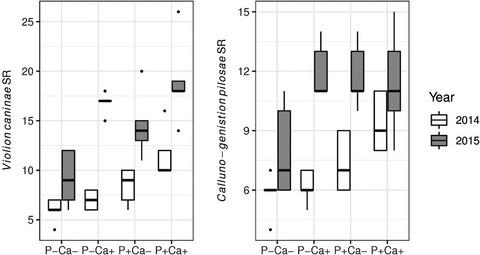当前位置:
X-MOL 学术
›
Appl. Veg. Sci.
›
论文详情
Our official English website, www.x-mol.net, welcomes your feedback! (Note: you will need to create a separate account there.)
Barriers to restoration: Soil acidity and phosphorus limitation constrain recovery of heathland plant communities after sod cutting
Applied Vegetation Science ( IF 2.8 ) Pub Date : 2020-01-01 , DOI: 10.1111/avsc.12471 Joost J. Vogels 1, 2 , Maaike J. Weijters 3 , Roland Bobbink 3 , Rienk‐Jan Bijlsma 4 , Leon P. M. Lamers 5 , Wilco C. E. P. Verberk 2 , Henk Siepel 2
Applied Vegetation Science ( IF 2.8 ) Pub Date : 2020-01-01 , DOI: 10.1111/avsc.12471 Joost J. Vogels 1, 2 , Maaike J. Weijters 3 , Roland Bobbink 3 , Rienk‐Jan Bijlsma 4 , Leon P. M. Lamers 5 , Wilco C. E. P. Verberk 2 , Henk Siepel 2
Affiliation

|
QUESTIONS: Sod cutting has been used extensively as an effective measure in removing excess N and restoring dwarf shrub dominance in heathlands affected by increased nitrogen deposition. However, recovery of other plant species is often very limited. One barrier is high soil acidity following sod cutting, which results in soil aluminium (Al³⁺) and ammonium (NH₄⁺) reaching toxic concentrations. Sod‐cutting management also removes most of the major nutrients from the system, so intensified nutrient limitation could be an additional barrier to the recovery of species‐rich communities. Soil phosphorus (P) is of special interest as research indicates sod‐cutting management can shift the system to P limitation. LOCATION: Hoge Veluwe National Park, The Netherlands. METHODS: We set up a full‐factorial experiment in sod‐cut heathland formerly encroached by Molinia caerulea, adding phosphate (P+) and lime (Ca+) and over the next three growing seasons, we recorded soil chemistry and plant responses. RESULTS: Soil inorganic N, especially soil NH₄⁺, strongly declined after liming compared to the control situation, confirming that liming alleviates NH₄⁺ toxicity. Addition of P resulted in a similar decline, also suggesting a role for soil phosphate availability in this process. Acid‐sensitive plant species richness increased significantly in both Ca+ and P+ treatment, whereas acid‐insensitive plant species richness only increased significantly as a result of P+ treatment. Mean vegetation relative growth rate increased significantly in both Ca+ and P+ treatments. CONCLUSIONS: Excessive P removal due to sod cutting constitutes a second barrier to restoration in addition to soil acidity. We discourage the large‐scale use of sod cutting to reduce soil N availability in heathlands and propose to use interventions that leave the soil nutrient balance intact, such as burning and grazing, mowing or litter removal, in combination with measures that restore the soil buffer capacity.
中文翻译:

恢复障碍:土壤酸度和磷限制限制草皮切割后石南植物群落的恢复
问题:草皮切割已被广泛用作在受氮沉积增加影响的荒地中去除过量氮和恢复矮灌木优势的有效措施。然而,其他植物物种的恢复通常非常有限。一个障碍是草皮切割后土壤酸度高,这导致土壤铝 (Al³⁺) 和铵 (NH₄⁺) 达到有毒浓度。草皮切割管理还从系统中去除了大部分主要营养物质,因此强化营养限制可能是物种丰富群落恢复的额外障碍。土壤磷 (P) 是特别令人感兴趣的,因为研究表明割草管理可以将系统转移到 P 限制。地点:荷兰Hoge Veluwe国家公园。方法:我们在以前被蓝藻侵占的草皮荒地中建立了一个全因子实验,添加磷酸盐 (P+) 和石灰 (Ca+),在接下来的三个生长季节,我们记录了土壤化学和植物反应。结果:与对照情况相比,施石灰后土壤无机氮,尤其是土壤 NH₄⁺ 显着下降,证实了施石灰减轻了 NH₄⁺ 的毒性。磷的添加导致了类似的下降,这也表明土壤磷的有效性在这个过程中发挥了作用。酸敏感植物物种丰富度在 Ca+ 和 P+ 处理中均显着增加,而酸不敏感植物物种丰富度仅在 P+ 处理中显着增加。平均植被相对增长率在Ca+和P+处理中均显着增加。结论:除土壤酸度外,由于草皮切割造成的过量磷去除构成了恢复的第二个障碍。我们不鼓励大规模使用草皮切割来减少石南荒地土壤氮的可用性,并建议使用保持土壤养分平衡不变的干预措施,例如燃烧和放牧、割草或清除垃圾,并结合恢复土壤缓冲的措施容量。
更新日期:2020-01-01
中文翻译:

恢复障碍:土壤酸度和磷限制限制草皮切割后石南植物群落的恢复
问题:草皮切割已被广泛用作在受氮沉积增加影响的荒地中去除过量氮和恢复矮灌木优势的有效措施。然而,其他植物物种的恢复通常非常有限。一个障碍是草皮切割后土壤酸度高,这导致土壤铝 (Al³⁺) 和铵 (NH₄⁺) 达到有毒浓度。草皮切割管理还从系统中去除了大部分主要营养物质,因此强化营养限制可能是物种丰富群落恢复的额外障碍。土壤磷 (P) 是特别令人感兴趣的,因为研究表明割草管理可以将系统转移到 P 限制。地点:荷兰Hoge Veluwe国家公园。方法:我们在以前被蓝藻侵占的草皮荒地中建立了一个全因子实验,添加磷酸盐 (P+) 和石灰 (Ca+),在接下来的三个生长季节,我们记录了土壤化学和植物反应。结果:与对照情况相比,施石灰后土壤无机氮,尤其是土壤 NH₄⁺ 显着下降,证实了施石灰减轻了 NH₄⁺ 的毒性。磷的添加导致了类似的下降,这也表明土壤磷的有效性在这个过程中发挥了作用。酸敏感植物物种丰富度在 Ca+ 和 P+ 处理中均显着增加,而酸不敏感植物物种丰富度仅在 P+ 处理中显着增加。平均植被相对增长率在Ca+和P+处理中均显着增加。结论:除土壤酸度外,由于草皮切割造成的过量磷去除构成了恢复的第二个障碍。我们不鼓励大规模使用草皮切割来减少石南荒地土壤氮的可用性,并建议使用保持土壤养分平衡不变的干预措施,例如燃烧和放牧、割草或清除垃圾,并结合恢复土壤缓冲的措施容量。



























 京公网安备 11010802027423号
京公网安备 11010802027423号